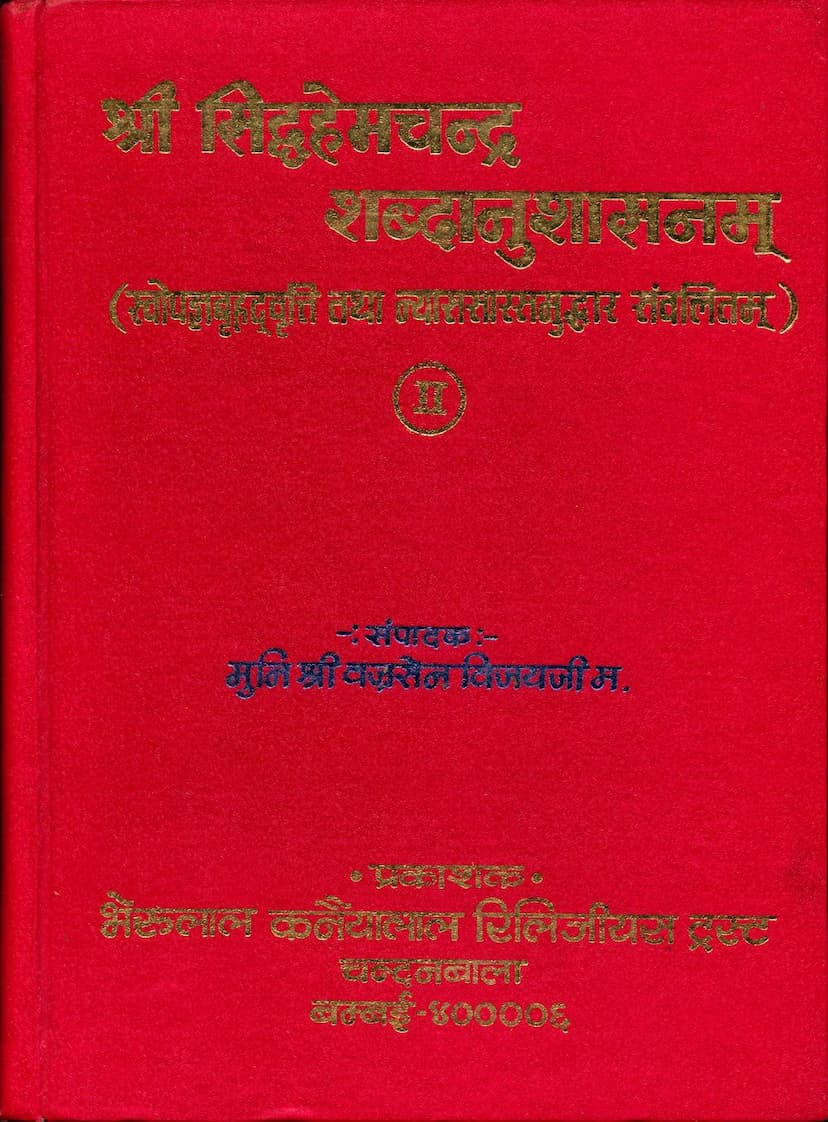Siddha Hemchandra Shabdanushasan Bruhad Vrutti Part 02
Added to library: September 2, 2025

Summary
Siddha Hemchandra Shabdanushasan Bruhad Vrutti Part 02: A Comprehensive Summary
This document is the second part of the "Bruhad Vrutti" (detailed commentary) on the "Siddha Hemchandra Shabdanushasan," a monumental grammar of the Sanskrit language authored by the illustrious Jain Acharya Hemchandra. The commentary itself, compiled by Pujya Munivar Shri Vajrasenvijayji M. Sa., is a continuation of the profound work initiated under the inspiration of Acharya Dev Shrimad Vijay Nemisurishwarji Maharaj Saheb and further facilitated by Acharya Dev Shrimad Vijay Udaysurishwarji Maharaj.
Key Information:
- Title: Siddha Hemchandra Shabdanushasan Bruhad Vrutti Part 02
- Author: Vajrasenvijay
- Publisher: Bherulal Kanaiyalal Religious Trust, Mumbai
- Publication Date: Kartik Shukla Purnima, 2042 (Vikram Samvat)
- Edition: Second
- Price: ₹70/-
- Catalog Link: https://jainqq.org/explore/032129/1
Summary of the Content (Based on the Provided Pages):
The provided text, consisting of pages 4 to 468, delves deep into the intricacies of Sanskrit grammar as presented in Acharya Hemchandra's "Siddha Hemchandra Shabdanushasan." The commentary, authored by Vajrasenvijay, meticulously explains various grammatical rules, concepts, and their applications with detailed explanations (Vrutti) and analytical discussions (Nyaya Saar Samuddhar/Laghu Nyas).
The content primarily focuses on the Third and Fourth Chapters (Adhyayas) of the Shabdanushasan, covering extensive sections on:
- Verbs (Dhatu): A significant portion of the text is dedicated to the analysis of verbs, including:
- Conjugations (Lakar): Detailed explanations of different tenses and moods like Vartamana (present), Sattami (optative), Panchami (imperative), Hyastani (imperfect), Adyatani (aorist), Paroksha (preterite), Shvastani (future), and Kriyativpatti (potential mood).
- Verb Conjugation Forms: The text elaborates on the formation of verb endings for various persons, numbers, and tenses.
- Root Modifications (Dhatu Vikar): Rules concerning vowel changes (Vriddhi, Guna), augmentations (Agama), replacements (Adesha), and elisions (Lop) are explained with numerous examples.
- Atmanepada and Parasamaipada: The usage and rules governing the causative (Nij), desiderative (San), and other specific verbal formations are thoroughly examined.
- Specific Verb Classes and Roots: The commentary systematically covers various verbal roots, their characteristic features, and the suffixes they take, often referencing specific classes like Churadi, Bhwadi, etc. The author provides extensive examples for each rule.
- The "Laghu Nyas" (Short Commentary) aspect: Throughout the text, the author frequently references and explains the "Laghu Nyas," likely a more concise commentary or a summary of key points, alongside the main "Bruhad Vrutti." This dual explanation offers a multi-layered understanding of the grammatical principles.
- Specific Grammatical Phenomena: The text also touches upon:
- San-pratyaya (Desiderative Suffix): Extensive coverage of the rules and exceptions related to the 'san' suffix, which forms desiderative verbs (expressing desire to do).
- Verb Formations and Their Semantics: The commentary often explains the nuances of meaning conveyed by different verbal formations and the specific contexts in which they are used.
- Nouns and Their Formation (Nam-dhatu): While the primary focus is on verbs, there are discussions on noun formation through various suffixes, often explained in relation to their verbal roots.
- Rules of Sound Change (Sandhi) and Augmentation: The application of rules like Vriddhi, Guna, and specific euphonic changes is illustrated with examples.
- Etymology and Usage: The author often clarifies the origin of certain forms and their specific semantic uses in classical Sanskrit literature.
- Structure and Pedagogy: The commentary is structured systematically, with each grammatical rule (Sutra) followed by its elaboration (Vrutti) and further clarification through logical reasoning and examples (Nyaya Saar). The author's deep scholarship and dedication to preserving and explaining Jain philosophical and linguistic heritage are evident.
Overall Significance:
"Siddha Hemchandra Shabdanushasan Bruhad Vrutti Part 02" is a scholarly work that serves as an invaluable resource for anyone seeking to understand the depth and complexity of Sanskrit grammar from a Jain perspective. It reflects the rich tradition of Jain scholarship in preserving and elaborating upon foundational texts, ensuring their continued relevance and accessibility for future generations. The publisher, Bherulal Kanaiyalal Religious Trust, plays a crucial role in making such significant religious and scholarly works available to the public.